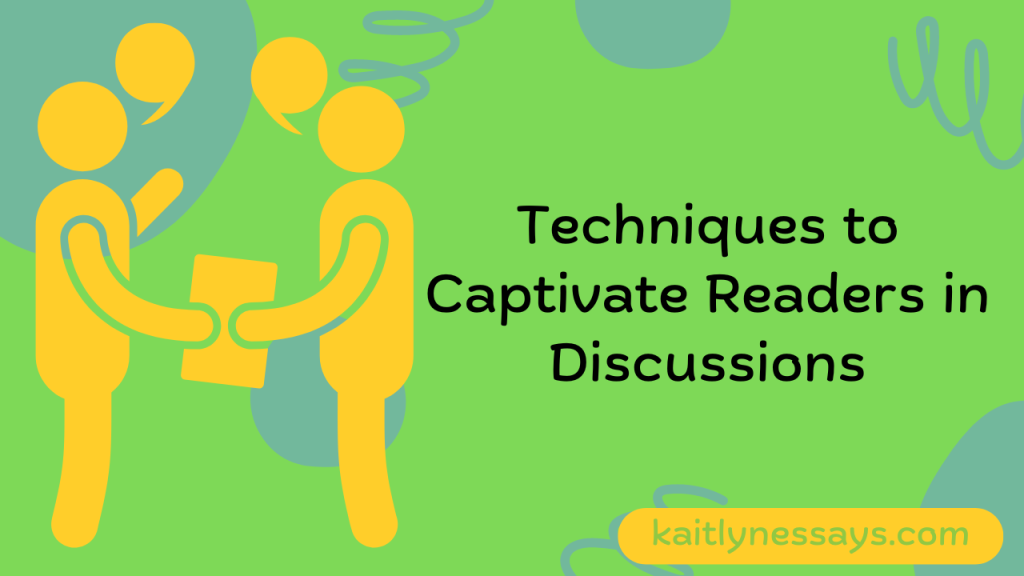
Engaging readers in discussions is a skill that transcends various domains, from literature to online forums and academic discourse. Whether you’re aiming to spark lively debates or foster meaningful exchanges of ideas, capturing and maintaining readers’ attention is essential. In this guide, we’ll explore techniques to captivate readers in discussions, drawing insights from psychology, communication theory, and practical experience.
Different readers have varying interests, backgrounds, and preferences, which can influence their engagement with the discussion. Tailoring your approach to resonate with your audience’s needs and expectations is key to capturing their attention and sustaining their interest.
According to Miller (2019), author of “Audience Analysis: A Guide for Speakers,” effective communication begins with understanding your audience’s demographics, attitudes, and values. By conducting audience analysis, you can gain insights into their interests, concerns, and communication preferences, allowing you to tailor your message to resonate with their needs and motivations.
Crafting Compelling Titles and Openers

The first step in captivating readers in discussions is grabbing their attention with compelling titles and openers. Just like a book cover or a movie trailer, the title and opening sentence serve as the initial hook that draws readers in and entices them to continue reading.
Research by Berger and Milkman (2012) in “What Makes Online Content Viral?” suggests that emotional arousal, practical utility, and novelty are key drivers of content sharing and engagement. Crafting titles that evoke curiosity, arouse emotions, or promise practical value can increase readers’ likelihood of clicking on and engaging with your discussion post.
Similarly, the opening sentence should be concise, intriguing, and relevant to the topic at hand. Whether it’s posing a thought-provoking question, sharing a surprising statistic, or presenting a compelling anecdote, the opener sets the tone for the discussion and encourages readers to delve deeper into the content.
Stimulating Curiosity and Intrigue
Curiosity is a powerful motivator that drives engagement and exploration. By stimulating readers’ curiosity and intrigue, you can encourage them to actively participate in the discussion and seek out additional information.
One effective technique is to introduce gaps or unresolved questions in your discussion posts. According to Loewenstein (1994), author of “The Psychology of Curiosity: A Review and Reinterpretation,” curiosity arises when there is a gap between what we know and what we want to know. By posing intriguing questions, presenting conflicting viewpoints, or teasing upcoming revelations, you can pique readers’ curiosity and motivate them to engage with the discussion to satisfy their informational hunger.
Furthermore, leveraging storytelling techniques can enhance engagement by creating emotional connections and narrative suspense. Sharing personal anecdotes, case studies, or real-world examples that illustrate key points can make the discussion more relatable and memorable, capturing readers’ imagination and encouraging them to invest emotionally in the topic.
Facilitating Interactive Elements

Interactivity is essential for keeping readers engaged and active in discussions. Instead of passively consuming content, interactive elements encourage readers to participate actively by sharing their thoughts, asking questions, and engaging with other participants.
One effective technique is to incorporate polls, surveys, or quizzes into your discussion posts. These interactive elements not only capture readers’ attention but also provide valuable feedback and insights into their opinions and preferences. By inviting readers to express their views and participate in decision-making processes, you empower them to take ownership of the discussion and contribute meaningfully to the conversation.
Additionally, encouraging comments, feedback, and discussions can foster a sense of community and collaboration among readers. Creating a supportive and inclusive environment where readers feel comfortable expressing their opinions, asking questions, and engaging in respectful debates can enhance the overall quality of the discussion and sustain readers’ interest over time.
Employing Visual Aids and Multimedia
Incorporating visual aids and multimedia elements can enhance the appeal and effectiveness of discussion posts. Visuals not only capture readers’ attention but also facilitate information processing and retention, making complex concepts more accessible and engaging.
Research by Mayer (2001) in “Multimedia Learning” suggests that multimedia presentations, which combine text with visuals such as images, diagrams, and videos, are more effective for learning and retention than text-only presentations. By leveraging visual aids to illustrate key points, reinforce concepts, and provide context, you can enhance readers’ understanding and engagement with the discussion content.
Furthermore, multimedia elements such as videos, podcasts, and interactive simulations offer alternative modes of content delivery that cater to diverse learning preferences and communication styles. Integrating multimedia resources into your discussion posts can appeal to readers’ visual and auditory senses, making the content more dynamic, immersive, and memorable.
Encouraging Active Participation and Feedback
Active participation is essential for sustaining readers’ interest and momentum in discussions. Instead of being passive spectators, readers should feel empowered to contribute their ideas, ask questions, and engage in meaningful dialogue with other participants.
One effective technique is encouraging open-ended questions and discussions inviting readers to share their perspectives and insights. According to Scott (2019), author of “The Art of Asking Questions: Techniques for Effective Communication and Problem Solving,” open-ended questions stimulate critical thinking, creativity, and active engagement by encouraging readers to explore complex issues from multiple angles and viewpoints.
Moreover, providing timely feedback and recognition can reinforce readers’ participation and encourage continued engagement. Acknowledging and responding to readers’ comments, questions, and contributions demonstrates that their voices are valued and appreciated, fostering a sense of belonging and community within the discussion forum.
Creating a Sense of Urgency and Scarcity
Creating a sense of urgency and scarcity can motivate readers to act quickly and engage with the discussion before time runs out. By highlighting time-sensitive information, limited-time offers, or exclusive opportunities, you can leverage the psychological principles of scarcity and FOMO (fear of missing out) to drive engagement and participation.
One effective technique is to use countdown timers or deadlines to create a sense of urgency and encourage readers to take immediate action. Whether it’s announcing a live Q&A session, a limited-time discount, or a deadline for submitting responses, setting clear time constraints can spur readers to prioritize the discussion and participate before it’s too late.
Furthermore, emphasizing the exclusivity or uniqueness of the discussion content can increase its perceived value and desirability. Whether it’s offering insider insights, exclusive access to experts, or behind-the-scenes updates, highlighting the special features or benefits of participating in the discussion can incentivize readers to join the conversation and reap the rewards.
Leveraging Social Proof and Authority
Social proof and authority are powerful persuasive techniques that can influence readers’ perceptions and behaviors. By showcasing endorsements, testimonials, or endorsements from credible sources, you can build trust, credibility, and confidence in the discussion content and encourage readers to engage with it.
One effective technique is to highlight testimonials or success stories from previous participants who have benefited from the discussion. Whether it’s sharing quotes, case studies, or user-generated content, showcasing positive experiences and outcomes can reassure readers that their participation is worthwhile and valuable.
Moreover, leveraging endorsements or testimonials from recognized authorities, experts, or influencers can enhance the perceived credibility and legitimacy of the discussion content. Whether it’s featuring quotes, endorsements, or testimonials from industry leaders, academics, or celebrities, associating the discussion with credible and authoritative figures can instill confidence and trust in readers and motivate them to engage with the content.
Conclusion
Captivating readers in discussions requires a combination of strategic techniques that appeal to their interests, emotions, and motivations. By understanding the audience, crafting compelling titles and openers, stimulating curiosity and intrigue, facilitating interactive elements, employing visual aids and multimedia, encouraging active participation and feedback, creating a sense of urgency and scarcity, and leveraging social proof and authority, you can capture readers’ attention and sustain their engagement in discussions.
As communicators and content creators, it’s essential to continually experiment with different techniques and strategies to keep readers captivated and invested in the discussion content. By fostering a dynamic and interactive environment where readers feel valued, heard, and inspired, you can create meaningful and memorable discussions that leave a lasting impact on participants.
Having difficulty expressing your ideas in writing? We are here to help. We specialize in offering high-quality academic writing services, ensuring that your paper is not only well-written but also demonstrates a thorough understanding of the subject. With our experienced professionals assisting you, you can transform any challenging topic into a finely crafted masterpiece.
Frequently Asked Questions (FAQs) About Techniques to Captivate Readers in Discussions
What are some effective techniques to captivate readers in discussions?
Effective techniques include crafting compelling titles and openers, stimulating curiosity, employing multimedia, encouraging active participation, leveraging social proof, and creating a sense of urgency or scarcity.
How can I understand my audience better to tailor my discussion content?
Conduct audience analysis to understand demographics, preferences, and communication styles. Consider factors such as interests, values, and motivations to tailor your content effectively.
Why is it important to encourage active participation in discussions?
Active participation fosters engagement, collaboration, and knowledge sharing among participants. It creates a dynamic and interactive environment where ideas can be exchanged, debated, and explored.
What role does multimedia play in captivating readers in discussions?
Multimedia elements such as images, videos, and interactive content enhance the appeal and effectiveness of discussions by providing visual and auditory stimulation, facilitating information processing, and increasing engagement.
How can I create a sense of urgency or scarcity in discussions?
You can create a sense of urgency or scarcity by highlighting time-sensitive information, limited-time offers, or exclusive opportunities. Using countdown timers, deadlines, or emphasizing exclusivity can motivate readers to engage quickly.
What is social proof, and how can it be leveraged to captivate readers in discussions?
Social proof refers to the psychological phenomenon where people are influenced by the actions and opinions of others. By showcasing endorsements, testimonials, or endorsements from credible sources, you can build trust and credibility in your discussion content.
How can I encourage active participation and feedback from readers?
Encourage open-ended questions, facilitate discussions, and provide opportunities for readers to share their perspectives and insights. Acknowledge and respond to readers’ comments, questions, and contributions to foster a sense of community and engagement.
What are some ways to stimulate curiosity and intrigue in discussions?
Stimulate curiosity by introducing gaps or unresolved questions, sharing surprising facts or anecdotes, and using storytelling techniques. Teasing upcoming revelations or presenting conflicting viewpoints can also pique readers’ curiosity and motivate them to engage further
